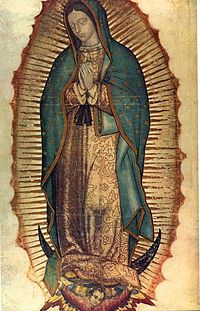December 12th is traditionally known in Mexico as the Day of the Virgin of Guadalupe (Día de la Virgin de Guadalupe), celebrating the manifestation of the Virgin Mary on Dec 9, 1531. It is the most important holiday in Mexico, even more important that Christmas, and is celebrated nationwide. Millions of pilgrims converge on the Mexico City Basilica to pay tribute to the country’s patron saint. In the weeks leading up to the holiday, the square in front of the Basilica is a stage for singing, dancing and celebration. And across the country pilgrimages, processions and fiestas are held to honor the Virgin.
The Virgin appeared to Aztec Juan Diego as he was on his way to morning services at a nearby church. He was stopped by the sound of heavenly music from the top of Tepeyac Hill—which was the former site of worship for the Aztec Goddess Tonántzin. He climbed the hill and saw a dark-skinned woman surrounded by light and music. She told him she wanted a temple built on the very spot they were standing. She spoke to him in his native tongue, Náhuatl, asked him to go the Bishop Zumárraga and request that a church be erected in her honor. Juan Diego went to the Bishop and made the request for the Virgin but as expected, the Bishop did not believe the Indian; he wanted proof. So several days later, when Juan Diego was rushing to find a priest for his dying uncle, the Virgin appeared again. She instructed him to take his tilma (a cape made from cactus fibers) and gather up all the roses that despite the winter frost, had miraculously grown at her feet. Juan Diego took these flowers to the Bishop, and as they poured out of his tilma, an image of the Virgin appeared on it. The image is one of the Virgin surrounded by the light of heaven and the stars of the winter solstice sky. It is this tilma, that is the relic of the Basílica de Guadalupe, for which millions of people from all over the world make a pilgrimage to the Tepeyac Shrine in Mexico City to view every year on the 12th of December.
The relic itself has been extensively studied over the years and its image is one of the most recognizable religious images in the world. The stars represented on the Virgin’s mantle are said to be the exact constellations that were present at the time the tilma was presented to the Bishop. The painting technique is said to resemble that of the Early Renaissance in the way the figure is presented and its gilded elements. The image contains both American and Mediterranean occidental symbols as well as Pre-Hispanic iconography. The image represents a combination of both cultures and became the impetus for the conversion of over six million Native Mexicans to Catholicism immediately following the sighting. The relic is made of coarse agave fibers and has been inexplicably preserved after 400 years of being touched and handled. And has withstood attempts at degradation by humidity, saltpeter and acid and remains complete and on display to this day.
All over Mexico, on the eve of the anniversary of the final appearance of the Virgin, and in the week before, churches, schools, organizations and businesses have their own processions through their towns. Young girls and boys are chosen to represent the Virgin and Juan Diego. The girls dress as the Virgin appeared in native dress with ribbons in their hair and the boys dress as Juan Diego with tilmas and straw hats. People decorate their cars and trucks with red roses and parade behind an ornate figure or painting of the Virgin, to their churches where a special mass is held.






